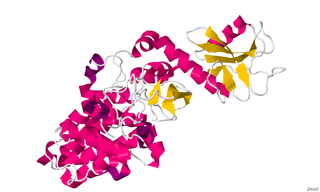Related Research Articles

A dendritic spine is a small membranous protrusion from a neuron's dendrite that typically receives input from a single axon at the synapse. Dendritic spines serve as a storage site for synaptic strength and help transmit electrical signals to the neuron's cell body. Most spines have a bulbous head, and a thin neck that connects the head of the spine to the shaft of the dendrite. The dendrites of a single neuron can contain hundreds to thousands of spines. In addition to spines providing an anatomical substrate for memory storage and synaptic transmission, they may also serve to increase the number of possible contacts between neurons. It has also been suggested that changes in the activity of neurons have a positive effect on spine morphology.

MHC Class II molecules are a class of major histocompatibility complex (MHC) molecules normally found only on professional antigen-presenting cells such as dendritic cells, mononuclear phagocytes, some endothelial cells, thymic epithelial cells, and B cells. These cells are important in initiating immune responses.

Chimerin 1, (CHN1) also known as alpha-1-chimerin, n-chimerin is a protein which in humans is encoded by the CHN1 gene.

Cyclin-dependent kinase 4 also known as cell division protein kinase 4 is an enzyme that in humans is encoded by the CDK4 gene. CDK4 is a member of the cyclin-dependent kinase family.
The Rho family of GTPases is a family of small signaling G proteins, and is a subfamily of the Ras superfamily. The members of the Rho GTPase family have been shown to regulate many aspects of intracellular actin dynamics, and are found in all eukaryotic kingdoms, including yeasts and some plants. Three members of the family have been studied in detail: Cdc42, Rac1, and RhoA. All G proteins are "molecular switches", and Rho proteins play a role in organelle development, cytoskeletal dynamics, cell movement, and other common cellular functions.

Cell division control protein 42 homolog, also known as Cdc42, is a protein involved in regulation of the cell cycle. It was originally identified in S. cerevisiae (yeast) as a mediator of cell division, and is now known to influence a variety of signaling events and cellular processes in a variety of organisms from yeast to mammals.

Serine/threonine-protein kinase PAK 1 is an enzyme that in humans is encoded by the PAK1 gene.

Platelet-derived growth factor receptor beta is a protein that in humans is encoded by the PDGFRB gene. Mutations in PDGFRB are mainly associated with the clonal eosinophilia class of malignancies.

Serine/threonine-protein kinase PAK 2 is an enzyme that in humans is encoded by the PAK2 gene.

Rac GTPase-activating protein 1 is an enzyme that in humans is encoded by the RACGAP1 gene.

LIM domain kinase 1 is an enzyme that in humans is encoded by the LIMK1 gene.

Rho guanine nucleotide exchange factor 7 is a protein that in humans is encoded by the ARHGEF7 gene.

Rho guanine nucleotide exchange factor 6 is a protein that, in humans, is encoded by the ARHGEF6 gene.

PAK3 is one of three members of Group I PAK family of evolutionary conserved serine/threonine kinases. PAK3 is preferentially expressed in neuronal cells and involved in synapse formation and plasticity and mental retardation.

Serine/threonine-protein kinase PAK 4 is an enzyme that in humans is encoded by the PAK4 gene.

Serine/threonine-protein kinase MRCK alpha is an enzyme that in humans is encoded by the CDC42BPA gene.

Serine/threonine-protein kinase PAK 5 is an enzyme that in humans is encoded by the PAK5 gene.

Serine/threonine-protein kinase PAK 6 is an enzyme that in humans is encoded by the PAK6 gene.
Fibroblast growth factor receptor oncogene partner 2 (FGFR1OP2) was identified in a study on myeloproliferative syndrome (EMS). The study aimed to identify the partner genes to the fibroblast growth factor receptor 1 (FGFR1) involved in the syndrome. Using the 5'-RACE PCR technique, FGFR1OP2 was identified as a novel gene with no known function.

EVI5L is a protein that in humans is encoded by the EVI5L gene. EVI5L is a member of the Ras superfamily of monomeric guanine nucleotide-binding (G) proteins, and functions as a GTPase-activating protein (GAP) with a broad specificity. Measurement of in vitro Rab-GAP activity has shown that EVI5L has significant Rab2A- and Rab10-GAP activity.
References
- ↑ p21-Activated+Kinases at the US National Library of Medicine Medical Subject Headings (MeSH)
- ↑ "Entrez Gene: PAK1 p21/Cdc42/Rac1-activated kinase 1 (STE20 homolog, yeast)".
- ↑ "Entrez Gene: PAK2 p21 (CDKN1A)-activated kinase 2".
- ↑ "Entrez Gene: PAK3 p21 (CDKN1A)-activated kinase 3".
- ↑ "Entrez Gene: PAK4 p21(CDKN1A)-activated kinase 4".
- ↑ "PAK5 p21 (RAC1) activated kinase 5 [Homo sapiens (human)] - Gene - NCBI".
- ↑ "PAK6 p21 (RAC1) activated kinase 6 [Homo sapiens (human)] - Gene - NCBI".